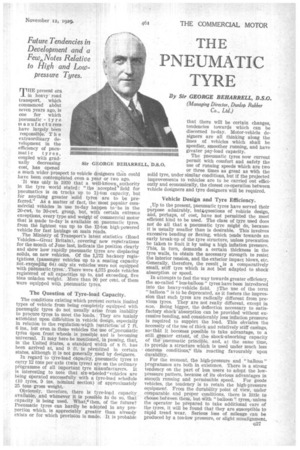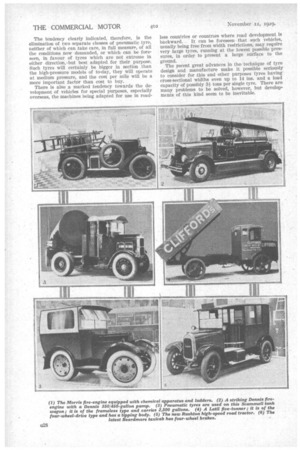TH E
Page 133

Page 134

If you've noticed an error in this article please click here to report it so we can fix it.
PNEUMATIC
TYR E By Sir GEORGE BEHARRELL, D.S.O.
(Managing Director, Dunlop Rubber Co„ Ltd.)
THE present era in heaVy• road transport, which commenced about seven years ago, is one for which pneumatic tyre in have largely been responsible.' T h e extraordinary development in the efficiency of pneu
matic tyres, coupled with gradually decreasing cost, has opened a much wider. Prospect to vehicle designers than could have been contemplated even a year or two ago.
'It was only in 1.920 that a well-known Lauthority in the tyre world stated: "the accepted field for
pneumatics is on trucks up to 1k-ton capacity, but for anything greater 'solid tyres are to. be preferred." AS a matter of fact, the most popular coin mereial vehicles in use to-day happen to' be in the 20-cwt. to 30-cwt. group, but, with certain extreme exceptions, every type and weiglit of commercial motor that is made to-day is available on pneumatic tyres, from the lightest van up to the 12-ton high-powered vehicle for fast haulage on main reads.
The Ministry 0:4 Transport's latest statistics (Road Vehicles—Great Britain), covering new registrations for the month of June last, indicate the position clearly and show how rapidly pneumatic tyres are displacing solids, on new vehicles. Of the 1,272 hackney regis tsations, (passenger vehicles up to a seating capacity not,exceedifig 64) only six vehicles were not equipped with Pieuniatic tyres:, There were 4,575 goods vehicles registered of all capacities up to, and exceeding, five tons unladen weight. More than 90 per cent. of them were equipped with pneumatic tyres.
The Question of Tyre-load Capacity.
The conditions existing which prevent Certain .limited types of vehicle from being completely equipped with pneumatic tyres do not usually arise from inability to procure tyres to meet the loads. They are mainly attendant upon difficulties in vehicle design, especially in relatien to the regulation-width restriction' of 7 ft. 6 ins., but even in these vehicles the use of pneumatic tyleS Upon front wheels is possible and is becoming universal. It may here be mentioned, in passing, that, in the United States, a standard width of 8 ft. has been arrived at, and 9 ft. is prnaitted in certain states, although it is not generally, used by designers.
In regard to tyre-load capacity, pneumatic tyres to carry 12 tens per axle (twin tyres) are on the ordinary programme of all important tyre Manufacturers. It is interesting to note that six-wheeled-vehicles are being operated successfully with a tyre-load schedule (10 tyres, 9 ins. nominal section) of approximately 25 tons gross weight.
Obviously, therefore, there is tyre-load capacity available, and whenever It is possible to do so, that capacity is being used. What!' then, of the future? Pneumatic tyres can hardly be adopted in any proportien which, is appreciably greater than already exists or for which provisiOn is made. It is probable
that there will be certain changes, tendencies towards which can be discerned to-day. Motor-vehicle designers are all thinking along the lines of vehicles which shall be speedier, smoother running, and have greater pay-load capacity.
The pneumatic tyres now current permit with comfort and safety the use of running speeds which are two or three times as great as with the solid tyre, under similar conditions, but if the projected improvements to vehicles are to be carried out efficiently and economically, the closest co-operation between vehicle designers and tyre designers will be required.
Vehicle Design and Tyre Efficiency.
,Up to the present, pneumatic tyres have served their purpose admirably, but‘questions of vehicle design, and, perhaps, of cost, have not permitted the most efficient kind to be used. The class of tyre used does not do all that a pneumatic tyre might do, because it is usually smaller than is desirable. This involves excessive bending or flexing, which tends towards an early break-up of the tyre structure, unless precaution be taken to limit it by using a high inflation pressure. This, in turn, demands a certain thickness in the tyre walls, to obtain the necessary strength to resist the interior tension, and the exterior impact blows, etc. Generally, therefore, the result Js a comparatively small, stiff tyre Which is not best adapted to shock absorption or speed.
In attempts to feel the way towards greater efficiency, the so-called " bus-balloon " tyres have been introduced into the heavy-vehicle field. tiThe use of the term " balloon " is to be deprecated, as it fosters the impression that such tyres are radically different from previous tyres. They are not really different, except in me. Being. bigger, the deflection necessary to satisfactory shock'abSorption can be provided without excessive bending, and considerably less inflation pressure Is required to support the load. This obviates the necessity of the use of thick and relatively stiff casings, soP. that it becomes possible to take advantage, to a still greater extent, of the shock-absorbing capacity of the pneumatic principle, and, at the same time, . to provide a structure which is used under much less onerous conditions," this reacting favourably upon durability.
For the moment, the high-pressure and " balloon " prog,rainmes are both in existence. There is a strong tendency on the part of bus users to adopt the lowpressure pattern, because of its obvious advantages in smooth running and permissible speed. For goods vehicles, the tendency is to retain the high-pressure equipment. From the durability point of view, under comparable and proper conditions, there is little to choose between them, but.With "balloon " tyres, .unless the operator be prepared to take additional care of the tyres, it will be found that they are susceptible to rapid tread wear. Serious loss of mileage can be produced by a too-low pressure, or slight misalignment. The tendency clearly indicated, therefore, is the elimination of two separate classes of pneumatic tyre, neither of which can take care, in full measure, of all the conditions now demanded, or which can be foreseen, in favour of tyres which are not extreme in either directionobut best adapted for their purpose. Such tyres will certainly be bigger in section than the high-pressure models of to-day, they will operate at medium pressure, and the cost per mile will be a more important factor than cost to buy.
There is also a marked tendency towards the development of vehicles for special purposes, especially overseas, the machines being adapted for use in road
less countries or countries where road development Is backward. It can be foreseen that such vehicles, usually being free from width restrictions, may require very large tyres, running at the lowest possible pressures, in order to present a large surface to the ground. The recent great advances in the/ technique of tyre
design and manufacture make it possible seriously to consider for this and other purposes tyres having cross-sectional widths even up to 14 ins, and a load capacity of possibly al tons per single tyre. There are many problems to be solved, however, but developments of this kind seem to be inevitable.








































































































































































































































































































































